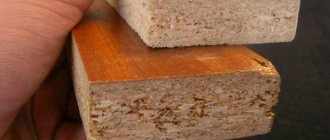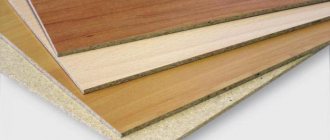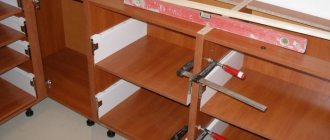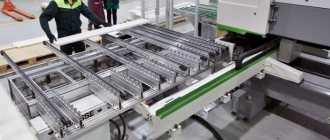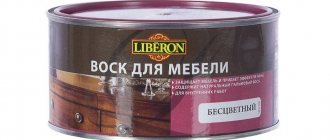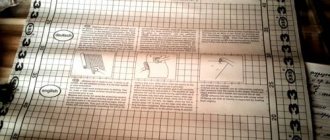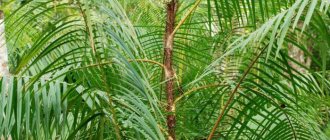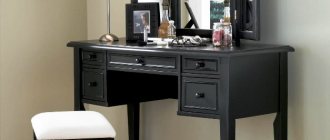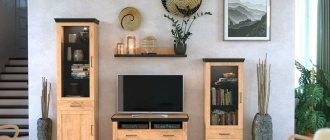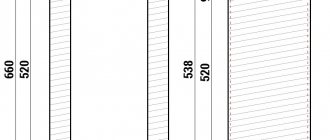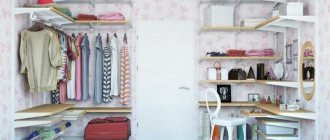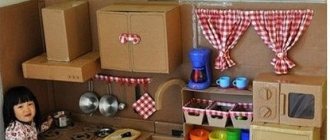Not everyone can make furniture from wood on their own—certain skills are required. You even need to be able to work with wood planks, and even more so with solid wood. The situation is much simpler with furniture made from laminated chipboards (LDSP). This is sheet material with an already processed front surface. All you need to do is assemble the parts cut to size. The situation is even simpler when decorating rooms: finished laminated chipboards are mounted on the sheathing, the seams are decorated with decorative strips. Let's talk about this material - laminated chipboard.
Production technology
For the production of laminated chipboard (LDSP), a first-class source material is used - chipboard. It must be without signs of defects, delamination, foreign inclusions, etc. The slabs are polished, then fed to the press, where the lamination process takes place.
The chipboard sheet is covered with specially treated paper. The color can be different - from monochromatic to recreating natural materials: wood of different species, stone, cork, etc. Maybe with some kind of pattern. The paper is impregnated with melamine, a substance that is insoluble in water and most solvents. Thanks to this impregnation, lamination paper becomes durable and moisture resistant.
Melamine paper is placed on the prepared sheet, then fed to the press
The prepared chipboard sheet is placed in a special press, and a sheet of melamine paper is placed on top. Next, the press comes into play. These are two horizontal plates. If necessary, a textured pattern imitating the structure of wood, stone, etc. is applied to the lower surface of the upper slab. Oil heated to high temperatures (140-230°C) circulates inside the press plates.
The texture and color of laminated chipboard may vary
The lower, movable part of the press lifts the material laid on it and, for a few seconds, presses it against the upper part of the press. The pressure is created high - more than 20 atm, so that the applied textured pattern is pressed into the slab. At the same time, heating melts the melamine and the surface layer of the “base” chipboard. Melamine penetrates the surface, firmly and rigidly fixing the paper to the material. After melamine hardens, a strong, hard film is formed on the surface, which is difficult to damage even with sharp and hard objects. The process is repeated on the other side, then the edges are processed.
What do salt and chipboard have in common?
What happens if you combine two poisons to form a new substance? Correct: a new substance with unique properties. A clear confirmation of this is kitchen table salt, ordinary sodium chloride.
Chlorine is a toxic asphyxiating gas. Pure sodium is flammable, and as a result of its violent reaction with water, a caustic alkali is formed. But the combination of these two substances - sodium chloride - plays an important role in human life. So important that people on average consume up to five kilograms of salt per year. At the same time, no one even thinks of comparing it with chlorine or sodium - the properties are not the same.
Now let's return to formaldehyde resins. This is also a completely new substance, which is produced from toxic, flammable and carcinogenic phenol and formaldehyde. Properly cured resin is an absolutely harmless substance. The only danger is the unreacted formaldehyde residues.
It should be borne in mind that most of this carcinogen evaporates during the production of plates that undergo high-temperature treatment. Then these products undergo certification, as a result of which the emission class (emission amount) of formaldehyde is determined.
Well, the final stage of processing furniture chipboard and MDF is lamination - coating with melamine film or special varnishes, which almost completely eliminate the interaction of the board with the environment. That is, even those formaldehyde residues that are allowed by the standards are sealed inside the slab and practically do not evaporate into the atmosphere (with the exception of the open ends of the furniture). But what happens if the coating is damaged?
Properties
Since laminated chipboard is produced on the basis of particle board, some properties and characteristics are “inherited” from the base material. The binder remains the same - it may contain phenolic resins. Therefore, formaldehyde emissions must be controlled. If this indicator is not indicated on the information sheet, you need to come close to the stack of material and evaluate the smell. If the laminated chipboard is made on the basis of boards with an emission class no higher than E1, you will not notice a special smell. If there is a smell, we advise you not to respond to assurances that the material has just been received from production and that in a couple of days/week/month there will be nothing left of the smell. Normal material does not smell - this is an axiom that does not require proof.
What to look for when choosing laminated chipboard
The film deposited on the surface still makes adjustments to many indicators:
- Laminated particle boards withstand regular wet cleaning. If a waterproof material is laminated, with high-quality glued edges it can be exposed to high humidity conditions for a long time without any special changes in geometry.
- Laminated chipboard is more resistant to ultraviolet radiation, high temperatures, and mechanical stress. Of course, you shouldn’t hit the surface with a hammer, but such a surface will easily withstand repeated movement of ordinary objects.
- Easy to care for. The hard and dense film allows you to easily remove any dirt, since it is not absorbed but remains on the surface.
- Varied design. Films can be plain, any color from the palette, plus with various effects - metallic, etc. There is a lot of imitation wood, a little less stone and ceramic tiles. You can also find various geometric or floral patterns, but there are few of them; such slabs are made or imported to order, so they cannot cost much.
At the same time, the bending strength remains the same as that of conventional chipboard and depends on the qualities of the source material.
Russian consumers are familiar with Lamarty products produced at the Syktyvkar plywood plant. Chipboard Lamarty (Lamarty) allows you to create original decor and furniture.
Chipboard Lamarty. Real marble effect
Decor "Shinon"
Safety
The production technology of board materials implies that MDF contains less harmful substances than chipboard. We are talking about volatile substances released by resins (used as binders), harmful to humans, which gradually (during long-term operation) “evaporate” and accumulate in the air if there is no sufficient ventilation of the room. All these substances do not cause immediate damage to the human body and have a harmful effect only with prolonged contact with them (in other words, if you decide to lie on a chipboard or MDF board for a long time, you will die not from poisoning with the substances they secrete, but from thirst, hunger or from old age).
However, manufacturers still established a certain gradation:
- MDF - with strict adherence to technology and high-quality cladding of surfaces, structures made from it are considered the least dangerous in terms of the release of harmful substances into the surrounding air. In the production of MDF, the main binder is lignin, released during the heating of wood. Therefore, high-quality MDF is environmentally friendly;
— E1 class chipboard – ranks second in terms of safety for the human body (but also only with appropriate surface cladding);
— Class E2 chipboard – emits the largest amount of harmful substances, is prohibited for production in foreign countries, and in Russia it is prohibited for the production of furniture and products used inside public and residential premises (GOST 10632-2007).
The difficulty of determining the harm actually caused by these materials is that the information recorded in the certificates is not always true (and sometimes the certificates attached to the materials are not “original” ones, that is, compiled based on the results of tests, but “purchased ones”). In addition, not all manufacturers (especially Russian ones) follow the recommended process technology for the production of MDF and chipboard, trying to save money by using lower quality resins.
How to choose high-quality laminated chipboards
When choosing laminated chipboard, in addition to “sniffing” the material, determining compliance with formaldehyde emissions, you need to pay attention to the end of the board. The material should be dense, without any large voids. The chips must be compressed, the gaps filled with a binder. The presence of cavities of any size is a sign of low quality.
The bottom sample is denser. You can't put keys in it
If you try to stick a hard object into the end (a door key, for example), the end should remain undamaged. If chips fall out during such a test, the source material is of poor quality. It will be difficult to tighten self-tapping screws into such a slab even once - they can wobble and fly out. There is no talk of reassembly at all.
It is impossible to make good furniture from low-quality laminated chipboard
If you are buying laminated chipboard to make furniture yourself, try to find a material with a high birch content. It differs in density, and therefore in weight - a slab of the same size and thickness weighs 30-40% more. It is problematic to drive even an awl into the end, let alone keys. What is good about this type of chipboard for furniture? Because the holes are well milled in it, the screws do not wobble even after being screwed in again.
Surface types
In addition to different colors, the front surface of laminated chipboard can be different - smooth, repeating the texture of wood or stone, or any other. To make it immediately clear what a laminated surface looks like, letter designations have been developed for the most common samples. Often found:
- SM – smooth, glossy, can be any color, including “wood”, but there are no characteristic irregularities or protrusions;
- SE – a board with coloring and a surface that imitates the structure of wood;
- RE – slightly pimply, similar to the peel of an orange;
- PR - porous, reminiscent of the structure of stone.
Types of Egger chipboard surfaces
There are many others. Large enterprises specializing in the production of laminated chipboards have several dozen types of surfaces. For example, in the photo above, the range of laminated panel surfaces offered by the famous Austrian manufacturer EGGER.
Types of chipboard in furniture
Manufacturers label the structure of laminated chipboard differently, but usually like this:
- BS is office;
- SE – wood with surface pores;
- SM - smooth surface;
- MAT - matte smooth surface;
- PR – porous structure;
- PE – “orange peel”.
Regardless of the application method, such chipboard is called melamine-coated chipboard.
For production, the first two are most often used: BS and SE. PR is also popular, but is used less frequently; SM is used in the production of internal partitions. Other markings may occur.
Widely used for making furniture, filling coupe doors and other interior decoration elements.
Application
The main area of application of laminated chipboard is furniture production. Just a couple of decades ago, this material had no special competitors: almost all cabinet furniture was made from laminated chipboards. Today, more and more furniture is made from MDF. This material is much more expensive, but allows you to create nonlinear surfaces and form highly complex patterns. All this cannot be done from chipboard. In addition, MDF tolerates high humidity even better.
Laminated chipboard furniture in a modern style
But the high cost greatly limits the spread of MDF furniture. Therefore, they mainly make combined cabinet furniture: frames, shelves, partitions - from laminated chipboard, facades, tabletops - from MDF. A reasonable compromise and no need to decide which is better - MDF or laminated chipboard.
Wall decoration with laminated chipboard panels can have a modern look
The second area of application for laminated chipboard is finishing work. You can cover walls with laminated chipboard panels, avoiding leveling the walls with plaster. Although this type of finish is not at the peak of popularity now, it can be used in interiors of any style. Wood-look laminated chipboard panels fit best into a classic interior. Plain-colored options can be used in modern, modern, art deco and even high-tech styles.
Chipboard in furniture: 50 photo ideas
PreviousOther Functional decorative element - chair covers
Next
OtherFurniture wax: types, application, how to use correctly.
Laminated chipboard: sheet sizes, shelf thickness
Standard sheets of ordinary first grade particle boards are laminated. In size they can be exactly the same as the base material, and its dimensions are standardized by GOST. Dimensions according to GOST are given in the table.
Table of sizes of standard laminated chipboard sheets/boards
If you are going to make furniture, it is advisable to select the sheet sizes so that the remainder is either very small or substantial - it can be used for the following products. Companies that do cutting have programs that immediately estimate the layout. With their help, you can select the optimal parameters of the laminated chipboard.
A few words about the thickness of laminated chipboard for shelves. If you use too thin a sheet or make the shelf too long, the material may bend under load (and sometimes even without it). However, you will not find exact recommendations, since even GOST defines wide tolerances for the density and rigidity of particle boards. But furniture is often made from chipboard, so based on experience, the following recommendations were made:
- with a thickness of 16 mm, the maximum length is 600 mm;
- for 18 mm - 800 mm;
- for 20 mm - 1000 mm.
Much depends on the density of the slab.
This data is for shelves 30-40 cm deep and for shelves that are not secured at the ends (loosely lying on the holders). As the depth increases, the rigidity increases, which means the shelf can be made longer. Also, the length can increase if a stiffening rib is added along the edge - by nailing/screwing a decorative strip. Well, one more thing: the recommended lengths are given for average load. If you are making a bookshelf or planning to display stones on a shelf, it is better to take the thickness one step (1-2 mm) larger.
Advantages and disadvantages
The advantages of laminated chipboard include low price, variety of colors and textures, water resistance, and resistance to mechanical damage. In general, this is a good choice for both finishing work and furniture.
There are also disadvantages:
- Sheet material. To make panels or furniture, you have to cut it out. You can do this yourself even with a regular hand saw, but this will result in chips of the laminate along the edges, which does not improve the appearance of the product in any way. Therefore, you have to order cutting of chipboard in furniture shops. The service is not too expensive, but it is an additional expense.
One of the well-known and “expensive” chipboard manufacturers is Egger. Here's how his material differs - The laminated surface is highly resistant to water and water vapor. But the unprotected end absorbs moisture very well, as a result the edges swell. Therefore, when cutting, you must also order edging of all ends. Let it be a melamine end edge, but the cut must be protected.
- No matter how well the end is glued, water vapor still penetrates through it. If furniture is placed in a room with high humidity, over time the edges swell and the appearance of the furniture or decoration becomes worse.
The higher the density and more uniform the structure, the stronger and stronger the slab - Furniture made from chipboard does not tolerate reassembly very well. Having unscrewed the screw once, you will not tighten it the second time: it will wobble. Larger fasteners can be used. This will help to some extent. You can drill other holes - a centimeter nearby. But, as you understand, this does not guarantee a 100% result.
- You won’t be able to make shaped furniture or smooth, rounded lines from laminated boards—it’s not the right material. You can decorate with overlays and fittings. No other way.
Generally speaking, laminated chipboard is a good budget option for interior decoration or for creating furniture.
Different breeds - different furniture
All types of wood have special properties, so furniture made from them will not be the same in terms of quality. When choosing material for interior items, you need to consider the following points:
- According to hardness, wood is divided into soft species (pine, poplar, spruce, alder), hard (birch, oak, maple, ash) and very hard (hornbeam, iron birch, yew).
- Based on their resistance to decay, they distinguish between resistant wood (pine, ash, oak) and medium-resistant wood (the heartwood of beech, spruce). Birch, the sapwood part of beech, linden and aspen are more susceptible to rotting.
- According to the degree of density, wood is divided into dense (ash, apple), medium density (birch, beech, walnut, oak), low density (pine, aspen, spruce, alder).
For each piece of furniture, you need to select a separate type of wood, taking into account the characteristics of the upcoming use. For example, beech, despite its strength, does not tolerate contact with water well, so it is not advisable to make kitchen countertops from it. But for the manufacture of elegant bent chairs and respectable chests of drawers for bedrooms, this is an ideal material.
Birch will make beautiful and high-quality furniture for bedrooms, living rooms and children's rooms.
Solid oak is the choice of those who buy furniture “seriously and for a long time.” Products made from such wood are passed on by inheritance. Oak furniture looks very solid, but in small rooms it gives the impression of being somewhat bulky.
